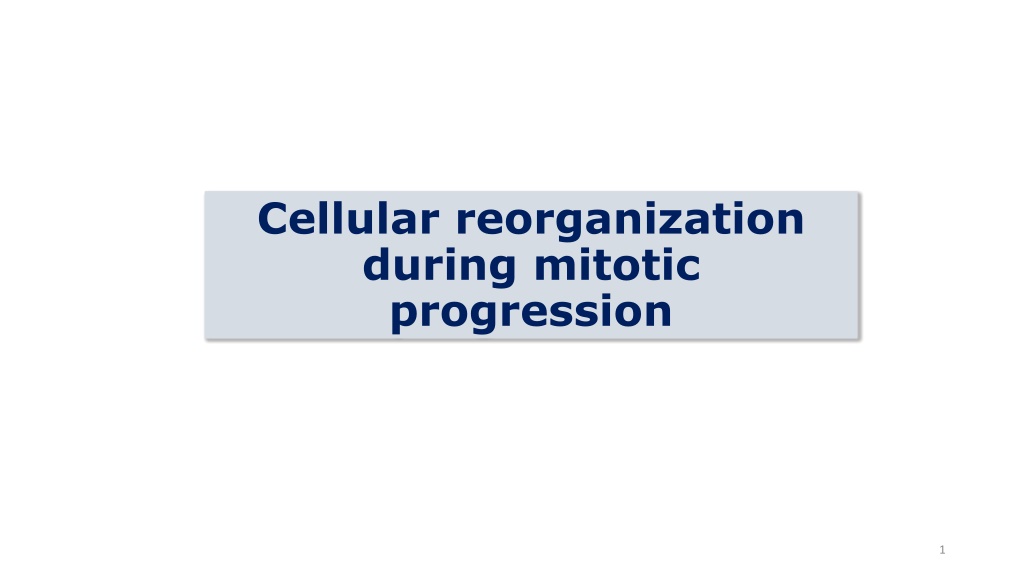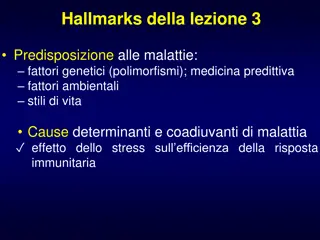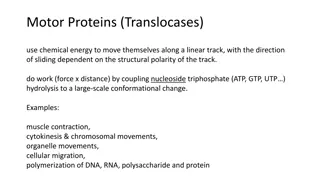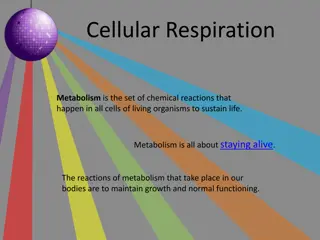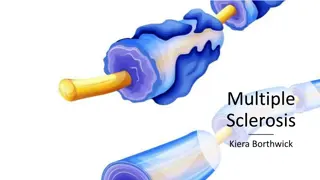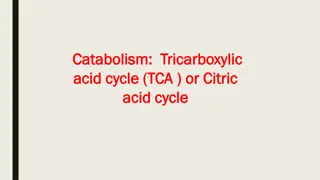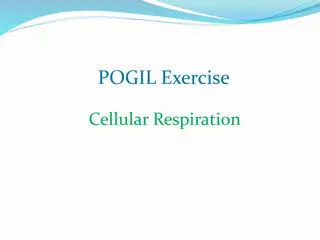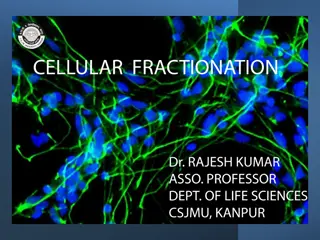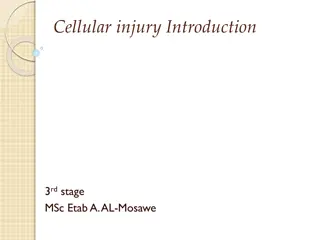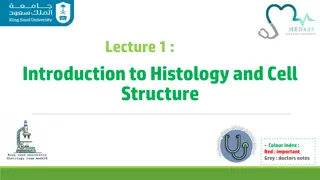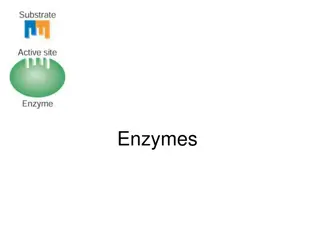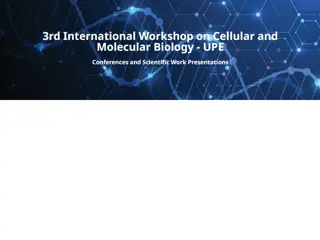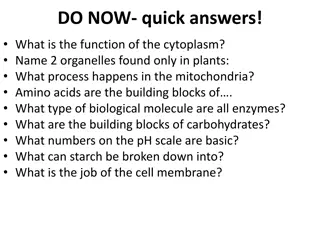Cellular reorganization during mitotic progression
The images and information depict the dynamic processes of cellular reorganization and transcriptional regulation during mitotic progression in cells. Topics covered include mitotic phases, transcription factors, E3 ligase complexes, and the role of APC/C in regulating cyclin degradation in the cell cycle.
Download Presentation

Please find below an Image/Link to download the presentation.
The content on the website is provided AS IS for your information and personal use only. It may not be sold, licensed, or shared on other websites without obtaining consent from the author.If you encounter any issues during the download, it is possible that the publisher has removed the file from their server.
You are allowed to download the files provided on this website for personal or commercial use, subject to the condition that they are used lawfully. All files are the property of their respective owners.
The content on the website is provided AS IS for your information and personal use only. It may not be sold, licensed, or shared on other websites without obtaining consent from the author.
E N D
Presentation Transcript
Cellular reorganization during mitotic progression 1
Transcriptional regulation during cell cycle progression The S phase cluster: 180 genes (Hcm1 as a transcription factor). The G2/M cluster or Clb2 cluster: 35 genes, Clb1, Clb2, Polo-like kinase Cdc5, Cdc20, transcription factors Ace2 and Swi5 (transcription factors of Sic1). Mcm1 is the trancription factor of G2/M cluster together with Fkh1, Fkh2 and the co-activator Ndd1 which are expressed in S-phase.
Cellular reorganization during mitotic progression Cyclin B CDK1 triggers entry to mitosis In prophase, the chromosomes condense, the centrosomes separate and the nuclear envelope breaks down In metaphase, chromosomes line up along the equatorial plane of the cell. In anaphase, the sister chromatids separate In telophase the DNA decondenses, the nuclear envelope reforms and the two daughter cells form by cytokinesis 3
Complex E3 di Saccharomyces cerevisiae Complex E3 Ligase SCF: Skp1-Cdc53 (Cullin)-F-box protein, G1/S transition APC Anaphase Promoting Complex, Metaphase/Anaphase transition SCF substrates: Sic1, Far1, Cdc6, Gcn4 (SCFCdc4 ) and Cln1,2 (SCFGrr1) APC substrates: Pds1, Clb2, Cdc20.
Anaphase-promoting complex/cyclosome (APC/C) The anaphase-promoting complex/ cyclosome (APC/C) is required for the destruction of cyclins and other proteins that are degraded from the end of metaphase until the onset of S-phase. The APC/C is a 20S multimeric complex that is required for the metaphase anaphase transition and cyclin degradation in vivo, and for high-rate cyclin ubiquitination in vitro. APC/C is composed of many different subunits (12 have been identified in humans and 13 in budding yeast). 5
A key early insight into the control of mitosis is the determination that progression from metaphase to anaphase involves ubiquitin-mediated proteolytic destruction of mitotic cyclins Cyclin destruction in mitosis is a key regulated step in the cell cycle and failure to degrade mitotic cyclin blocks division at metaphase arrest Down-regulation of mitotic cyclin-CDK activity is required to make the transition from M to G1 6
The best studied substrates of ubiquitin- and APC/C- mediated proteolysis are the mitotic cyclins. Murray et al. (1989) showed that sea urchin cyclin B lacking its first 90 residues could not be degraded and prevented exit from mitosis Analysis of the N-terminal region defined the sequence essential for cyclin proteolysis, the so called destruction box or D-box The consensus for the motif in B-type cyclins is RXALGXIXN, in which arginine (R) at position 1 and leucine (L) at position 4 are highly conserved except for cyclin B3, which has phenylalanine (F) instead of L at position 4. Mutations in the D-box stabilize cyclins and severely reduce or abolish their ubiquitination 7
Mitotic Mitotic cyclin cyclin destruction destruction box box Lys residues in quite close proximity to the D box serve as targets of ubiquitylation, consistent with findings that a Lys residue immediately C-terminal to the D box can function as a ubiquitin acceptor 8
APC/C APC/C subunits subunits and co and co- -activators activators 9
The APC/C The APC/C is an E3 ubiquitin ligase that recognizes specific mitotic proteins of anaphase onset In metaphase cells, APC/C is present but cannot trigger degradation of target proteins because its function requires association with one of two sequentially acting co-activating subunits, Cdc20 and Cdh1 Cdc20 acts first, associating with APC/C at the end of metaphase to form a complex denoted APCCdc20 APCCdc20-induced degradation of the B-type cyclin Clb2 is significantly slower, leading to a reduction of Cdk1 activity to only about 50% during anaphase Cdc28 inactivation for mitotic exit thus depends on additional mechanisms, involving stabilization and accumulation of the Cdk1 inhibitor protein Sic1 and activation of a second APC/C coactivator, Cdh1 APCCdc20 begins the destruction of mitotic cyclins (destruction box) Their complete degradation and persistent instability requires the the complex APCCdh1 One mechanistic reason for the transition between APCCdc20 and APCCdh1 is that activity of APCCdc20 is optimally maintained when cyclin CDK levels are high, while APCCdh1 function is actually antagonized by mitotic CDK phosphorylation 10
The APC/C is inactive from late G1 phase until early mitosis, which allows its main substrates to accumulate (securin, polo kinase and S-phase and mitotic cyclins). After cells have entered mitosis, the APC/C is activated by cyclin-Cdk1-dependent phosphorylation enhancing the ability of Cdc20 to bind the APC/C complex. APCCdc20 begins the destruction of mitotic cyclins, their complete degradation and persistent instability in the subsequent G1 phase requires the APC/C to associate with the Cdh1 subunit. This complex, known at APCCdh1, completes the inactivation of mitotic cyclin CDK. Cdh1 binds APC/C as cells exit mitosis 11
One mechanistic reason for the transition between APCCdc20 and APCCdh1 is that activity of APCCdc20 is optimally maintained when cyclin CDK levels are high, while APCCdh1 function is actually antagonized by mitotic CDK phosphorylation. Once mitosis is complete, APCCdh1 helps define the G1 state: it turns off mitotic exit by targeting the polo-family protein kinase Cdc5 for destruction in late M or early G1 and destabilizes mitotic cyclins throughout G1. When APC is active, it is imperative that it should not target securin and mitotic cyclins for destruction until all the chromosomes are attached to the mitotic apparatus (SAC, spindle assembly checkpopint). 12
CDC20 is an activator of the anaphase-promoting complex (APC), an E3 ubiquitin ligase in the ubiquitin-mediated proteolysis pathway. The APC ubiquitin ligase helps regulate the metaphase/anaphase transition and exit from mitosis/G1 entry through ubiquitination of various substrates. These include mitotic cyclins, the sister chromatid separation inhibitor Pds1p, the Kip1p and Cin8p motor proteins, Cdc5p, and the spindle disassembly factor, Ase1p. 13
cdc20-1 mutants arrest in metaphase before the activation of APC-dependent proteolysis. Analysis of the mutants demonstrated that Cdc20p regulates the activity and substrate specificity of the APC. It serves as an activator of the APC and mediates ubiquitin-dependent protein degradation of Pds1p, and the cyclins Clb5p and Clb3p at the metaphase-to- anaphase transition of the cell cycle. 14
The timing of the association of Cdc20p with the APC is regulated. The levels of Cdc20p rise as cells enter mitosis and fall as cells exit mitosis, with the result that Cdc20 is bound to the APC only during M phase (and possibly during late G2). CDH1, the other APC activator, is a homolog of CDC20. 15
APCCdc20 securin inhibitor protease separase Esp1) destroys (Pds1), of known (in yeast, an the as Separase cohesin proteins (Scc1 subunit) replicated chromosomes metaphase destroys that link sister at APCCdc20 Cyclin B destroys 17
APCCdc20 Pds1 (Securin) Esp1 (Separase) Scc1 cleavage (Cohesin) Sister chromatid separation Activated APCCdc20 initiates ubiquitination and degradation of mitotic cyclins and also completely destroys securin, an inhibitor of the protease known as separase (in yeast, Esp1) Separase destroys cohesin proteins (Scc1 subunit) that link replicated sister chromosomes at metaphase Separase promotes release of the phosphatase Cdc14 from inhibitory sequestration 18
The inactivation of CDK1 alone is not sufficient to drive mitotic exit, as CDK1 substrate dephosphorylation also depends on phosphatase activation in all organisms studied so far. In budding yeast, the main mitotic exit phosphatase is Cdc14, which mediates both completion of Cdk1 inactivation, by upregulating Sic1 and Cdh1, and dephosphorylation of Cdk1 substrates. Other organisms, however, seem to rely on distinct mitotic exit phosphatases, despite the presence of genes that are homologous to CDC14. 19
Cdc14: core regulator of mitotic exit events Two major molecular processes must occur for cells to pass from M phase into G1: 1) the mitotic cyclin CDK complex has to be inactivated 2) phosphorylation of key CDK substrates needs to be reversed APCCdc20 is critical for initiating cyclin destruction, chromatid separation elongation. APC is not sufficient for total destruction of mitotic cyclin or for completion of the M-to-G1 transition. and anaphase spindle 20
Cdc14: core regulator of mitotic exit events In budding yeast, completion of these tasks requires the phosphatase Cdc14. This CDK-counteracting phosphatase is inactive for most of the cell cycle because it is trapped in the nucleolus. As cells pass from metaphase to anaphase, this entrapment is weakened and Cdc14 eventually floods into the cytoplasm to reverse CDK phosphorylations. 21
The inhibitor Sic1 Sic1: inhibitor of cyclin-dependent kinase complexes SIC1 mRNA: accumulates in late anaphase (transcription factors Swi5 and Ace2) Sic1 G1 EXIT from MITOSIS Downregulates Clb2-Cdc28 activity Inhibits Clb5,6/Cdc28 kinase activity 22
Cdc14 acts in direct opposition to mitotic CDK and controls diverse processes Cdc14 is a dual-specificity phosphatase (DSP) that strongly dephosphorylates phosphoserines or that are immediately followed by proline, a motif that corresponds to a minimal CDK phosphorylation site. phosphothreonines Thus, the enzyme can reverse the phosphorylation state of mitotic CDK substrates. 23
Cdc14 acts in direct opposition to mitotic CDK and controls diverse processes Cdc14-3 mutants arrest in late anaphase with: 2C DNA content elongated mitotic spindle high levels of Clb2 protein lack of Sic1 protein high Clb2-associated kinase activity 24
Does Sic1 bind Cdc14 ? In vitro: Recombinant Sic1-GST coimmunoprecipitates with FLAG-tagged Cdc14. In vivo: WHICH EXPERIMENT? 25
Cdc14 Dephosphorylates Sic1 In Vitro Recombinant phosphorylated Cln2 Cdc28 kinase and then incubated with recombinant wild- type Cdc14 or a catalytically inactive Cdc14CS protein. Cdc14 is able to dephosphorylate Sic1 in vitro. Cdc14CS is dephosphorylate Sic1 in vitro. Cdc14 dephosphorylated compared to alkaline phosphatase. Sic1 is a physiological substrate of Cdc14. Sic1 with is purified not able to efficiently Sic1 intestinal if calf 26
Cdc14 is controlled by regulated sequestration to the nucleolus During mitotic division Cdc14 localizes to the nucleolus and is essentially inactive until the end of metaphase Specifically, Cdc14 binds the nucleolar protein Net1, also known as Cfi1. As cells begin anaphase, Cdc14 s anchoring to the nucleolus is weakened due to increased phosphorylation components of the anchoring system. of key 27
Cdc14 is controlled by regulated sequestration to the nucleolus The release of Cdc14 proceeds in two distinct stages: fourteen released from the nucleo, but only a very small amount the cytoplasm; 1) under the control of the FEAR pathway (Cdc early anaphase nucleolus into release), Cdc14 the is enters of the mitotic Cdc14 into the cytoplasm is triggered by the MEN (mitotic exit network). 2) coincident with cytokinesis and resolution spindle, sustained release of 28
